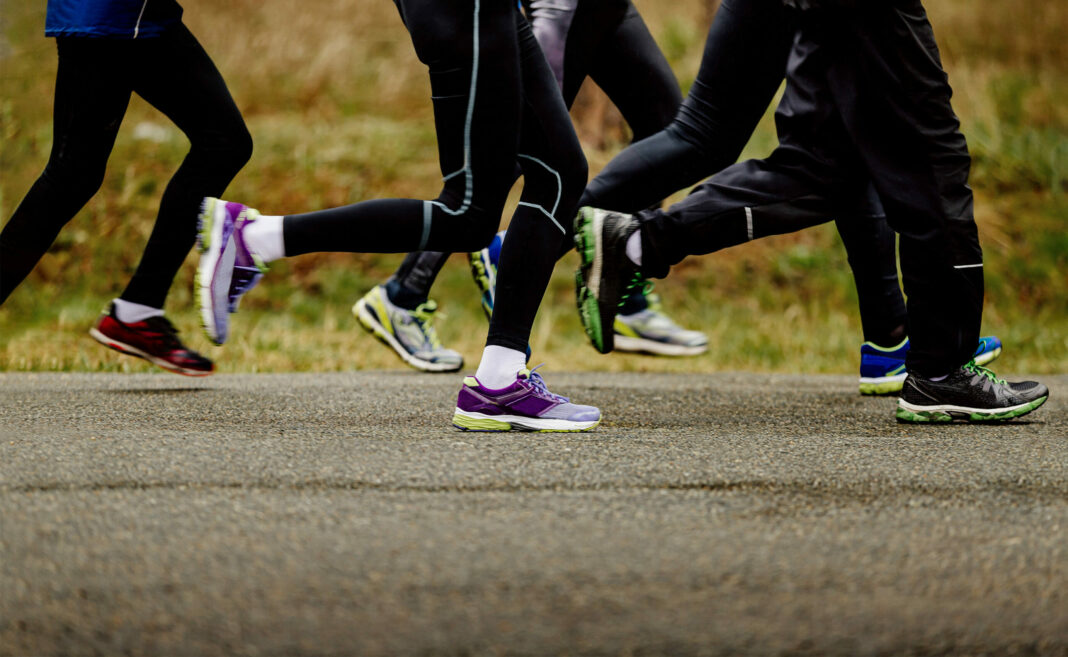All runners, regardless of the distance or surface for which they are training, should learn to run by feel. Training by ventilatory threshold, the talk test, and relative perceived exertion (RPE) will help athletes maximize performance in races of any distance.
Ventilatory Threshold
Exercise scientists call the point at which our breathing begins to increase at an accelerated rate the ventilatory threshold (VT). This ventilatory threshold falls between low and moderately intense efforts. So, the majority of training should be done below this threshold. Greg McMillan (McMillanrunning.com) calls the area just below the ventilatory threshold the ENDURANCE zone.
Talk Test
The talk test is one of the easiest and most effective ways to measure effort.
When training below the ventilatory threshold, we should be able to carry on a conversation. When our breathing accelerates, it impacts our ability to speak. As we approach our ventilatory and aerobic thresholds, we take in less oxygen. Consequently, rather than paragraphs at a time, we are limited to short sentences. The harder the effort, the shorter the sentences.
Steady state runs (2 – 2.5 hour race effort), the latter half or third of cut-down runs, tempo runs (one hour race effort), and critical velocity/cruise intervals (30 – 40 minimum race effort) fall between the ventilatory threshold and the aerobic threshold. McMillan refers to this category as the STAMINA zone.
As you cross the aerobic threshold and approach your VO2 Max, breathing becomes laboured. Rather than sentences, communication is limited to a few words at a time.
Shorter fartlek intervals, speed workouts, hill repeats, and races shorter than 30 minutes generally fall under this category. McMillan calls this the SPEED zone.
When you are pushing so hard that you aren’t getting any air, this means you are running anaerobically, and you won’t be able to sustain the effort or pace for more than a minute. When you can no longer utter a word, you are in the SPRINT zone. This is MAXIMAL effort. You are running beyond your VO2 Max—the effort you could sustain for 8 – 12 minutes.
Note: Depending on your age, injury history, training history, and the goal race for which you are training, it may not be prudent to do much training in the SPRINT zone.
Translating the Talk Test to Race Settings
Given that one can’t sustain an anaerobic effort for more than a minute, it stands to reason that we should try to avoid approaching anaerobic efforts/intensities in the early to middle parts of races that will last longer than a few minutes. This means we should avoid spiking the heart rate and gasping for air during the first half of many endurance events.
Similarly, one can only run at one’s aerobic threshold for up to an hour. Therefore, if you are racing for longer than an hour, you should aim to avoid crossing your aerobic threshold prior to the final hour of a race. That means, if you are racing a marathon you should be able to communicate with a fellow racer or volunteer through short sentences if necessary.
Racing By Effort
When Peak Run Performance athlete, Eric Reyes, ran the California International Marathon (CIM) he arrived at the half-marathon mark within the time range that he had set out to run despite multiple rolling hills. Unlike others aiming for a similar time, he didn’t reach his goal half-marathon split by running the exact same split for every mile. In fact, he had to remind himself constantly to throw pace out the window and approach the hills by effort.
Rather than limiting himself by a fixed pace, Reyes rolled through the hills and gradually pulled away from many others who entered the race with the same goal of running under 2:30. Unlike those set on running the same mile split from start to finish, he was able to push the second half of the race by not going beyond his threshold in the first half of the race.
Training By Effort
Reyes learned to race by effort through years of training on trails and running multiple trail races and ultramarathons. He had grown accustomed to long slogs up and down mountains, covering thousands of metres of vertical gain and loss in one race. Pacing and fuelling play an integral role in these longer efforts, so he learned early on to avoid spiking his heart rate or breathing to ensure he could sustain an effort for the duration of the event.
As he transitioned from the trails to the roads, he moved his marathon-specific workouts to paved paths, the treadmill, or the track. This enabled him to learn what his goal marathon pace felt like. He used pace and heart rate as training tools to help him better understand how his body was responding to the effort. Over time, Reyes learned how to listen to his body and find the optimal pace for each goal race without as much dependence on the watch.
You can also learn to train by effort by using ventilatory threshold, the talk test, and relative perceived exertion.
These are built-in, reliable metrics that you will always have with you, don’t have to recharge (except with sleep), and don’t have to worry about synchronizing with a satellite or your phone before or after each run.
Relative Perceived Exertion (RPE)
RPE can be measured on a scale of 1 to 10 with 1 being deep sleep and 10 being maximal effort (see graph below).
By learning to measure your effort through breathing, speaking, and perceived exertion, you’ll be better able to train intelligently and race strategically.
This article is edited for length and reprinted with permission from Jacob Puzey – www.peakrunperformance.com

The graphic illustrates the various effort levels of the talk test overlaying the Peak Run Performance Continuum with corresponding readings for RPE and heart rate zones, as well as the durations that a trained individual should be able to sustain the effort in a race setting.
You may also like: Rotating Your Running Shoes

Read This Story in Our 2024 Running Issue
Featuring Canadian Olympic, National & North American Marathon Record holder Cameron Levins. Run your way around the world with some cool, quirky and unconventional races. Train for 10 km right up to a marathon – plus a 25 km trail run and 70.3 program. Strength workouts for runners, spice it up to improve your performance and so much more.

















